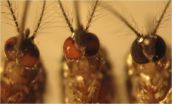(Press-News.org) Virginia Tech researchers successfully used a gene disruption technique to change the eye color of a mosquito — a critical step toward new genetic strategies aimed at disrupting the transmission of diseases such as dengue fever.
Zach Adelman and Kevin Myles, both associate professors of entomology in the College of Agriculture and Life Sciences and affiliated researchers with the Fralin Life Science Institute, study the transmission of vector-borne diseases and develop novel methods of control, based on genetics.
In a groundbreaking study recently published in the journal PLOS ONE, the scientists used a pair of engineered proteins to cut DNA in a site-specific manner to disrupt a targeted gene in the mosquito genome. Science magazine heralded these transcription activator-like effector nuclease proteins, known as TALENS, as a major scientific breakthrough in 2012, nicknaming them "genomic cruise missiles" for their ability to allow researchers to target specific locations with great efficiency.
While TALENS have been previously used to edit the genomes of animal and human cell cultures, applying them to the mosquito genome is a new approach, according to Adelman.
"Unlike model organisms with large collections of mutant strains to draw upon, the lack of reverse genetic tools in the mosquito has made it is very difficult to assign functions to genes in a definitive manner," Adelman said. "With the development of this technology, our understanding of the genetic basis of many critical behaviors such as blood-feeding, host-seeking and pathogen transmission should be greatly accelerated."
To test the capability of TALENs to specifically edit the mosquito genome, the scientists designed a pair of TALENS to target a gene whose protein product is essential to the production of eye pigmentation in Aedes aegypti, a mosquito species known for its transmission of the viruses that cause dengue fever.
Using the TALEN pair to edit the gene in the mosquito's germ cells early in development, they were able to change the eye color of a large percentage of the mosquitoes arising in the next generation from black to white.
"To date, efforts to control dengue transmission through genetics have focused entirely on adding material to the mosquito genome. Ensuring that this added material is expressed properly and consistently has been a challenge," Adelman said. "This technology allows us to pursue the same goals, namely, the generation of pathogen-resistant mosquitoes, through subtraction. For example, removing or altering a gene that is critical for pathogen replication."
"Aedes mosquitoes have become increasingly important as vectors of disease from a public health perspective," said George Dimopoulos, a professor of molecular microbiology and immunology at John Hopkins University who was not involved in the study. "The lack of vaccines and drugs for dengue has left the mosquitoes that carry the virus as one of the most promising targets for controlling the disease. A better understanding of how the virus infects the mosquito and other biological properties of the insect will be required to develop intervention strategies that can block virus transmission by the mosquito. The ability to genetically engineer mosquitoes is essential for the study of such biological functions. The TALEN-based system in mosquitoes that that was developed by Dr. Adelman provides this important capacity."
INFORMATION:
Co-authors of the study include Azadeh Aryan, a Ph.D. student in the department of entomology in the College of Agriculture and Life Sciences, and Michelle A.E. Anderson, a research technician in the department of entomology in the College of Agriculture and Life Sciences.
Virginia Tech researchers alter mosquito genome in step toward controlling disease
Fralin Life Science Institute researchers use TALENS to alter mosquito genome
2013-03-22
ELSE PRESS RELEASES FROM THIS DATE:
Multiple sclerosis research: The thalamus moves into the spotlight
2013-03-22
BUFFALO, N.Y. – A growing body of research by multiple sclerosis (MS) investigators at the University at Buffalo and international partners is providing powerful new evidence that the brain's gray matter reflects important changes in the disease that could allow clinicians to diagnose earlier and to better monitor and predict how the disease will progress.
Over the past three years, the UB researchers and their partners around the world, supported by an active fellowship program at UB's Buffalo Neuroimaging Analysis Center (BNAC), have published journal papers and given ...
Berkeley Lab researchers use metamaterials to observe giant photonic spin hall effect
2013-03-22
Researchers with the U.S. Department of Energy (DOE)'s Lawrence Berkeley National Laboratory (Berkeley Lab) have once again demonstrated the incredible capabilities of metamaterials – artificial nanoconstructs whose optical properties arise from their physical structure rather than their chemical composition. Engineering a unique two-dimensional sheet of gold nanoantennas, the researchers were able to obtain the strongest signal yet of the photonic spin Hall effect, an optical phenomenon of quantum mechanics that could play a prominent role in the future of computing.
"With ...
Program improves Ph.D. student diversity
2013-03-22
PROVIDENCE, R.I. [Brown University] — A new paper in the peer-reviewed journal CBE—Life Sciences Education describes a Brown University program that has significantly improved recruiting and performance of underrepresented minority students in its nine life sciences doctoral programs over the last four years.
Data in the paper show increases in applications, admissions, enrollments, test scores, grades and scientific publications and presentations among underrepresented minority students after implementation of the program called the Initiative to Maximize Student Development ...
New method developed to expand blood stem cells for bone marrow transplant
2013-03-22
NEW YORK (March 21, 2013) -- More than 50,000 stem cell transplants are performed each year worldwide. A research team led by Weill Cornell Medical College investigators may have solved a major issue of expanding adult hematopoietic stem cells (HSCs) outside the human body for clinical use in bone marrow transplantation -- a critical step towards producing a large supply of blood stem cells needed to restore a healthy blood system.
In the journal Blood, Weill Cornell researchers and collaborators from Memorial-Sloan Kettering Cancer Center describe how they engineered ...
Pain reliever shows anti-viral activity against flu
2013-03-22
The over-the-counter anti-inflammatory drug naproxen may also exhibit antiviral activity against influenza A virus, according to a team of French scientists. The finding, the result of a structure-based investigation, is published online ahead of print in the journal Antimicrobial Agents and Chemotherapy.
New influenza vaccines must be developed annually, because the surface proteins they target mutate rapidly, the way cars used to get a whole new look every year. The researchers, led by Anny Slama-Schwok of the Institut National de la Recherche Agronomique, Jouy en ...
Scientists create new tools for battling secondhand smoke
2013-03-22
Dartmouth researchers have taken an important step in the ongoing battle against secondhand tobacco smoke. They have pioneered the development of a breakthrough device that can immediately detect the presence of secondhand smoke and even third-hand smoke.
Smaller and lighter than a cellphone and about the size of a Matchbox car, the device uses polymer films to collect and measure nicotine in the air. A sensor chip then records the data on an SD memory card. The technology is described in a new study appearing in the journal Nicotine and Tobacco Research.
"We have ...
Study offers new way to discover HIV vaccine targets
2013-03-22
Decades of research and three large-scale clinical trials have so far failed to yield an effective HIV vaccine, in large part because the virus evolves so rapidly that it can evade any vaccine-induced immune response.
Researchers from the Ragon Institute of MGH, MIT and Harvard University have now developed a new approach to vaccine design that may allow them to cut off those evolutionary escape routes. The researchers have developed and experimentally validated a computational method that can analyze viral protein sequences to determine how well different viral strains ...
Banning food ads targeted at kids
2013-03-22
Researchers from the University of Alberta are leading a charge among Canada's obesity experts and calling on the federal government to ban food and beverage ads that target children.
Kim Raine, a professor with the Centre for Health Promotion Studies in the School of Public Health at the U of A, says governments need to take action to stem the rising obesity epidemic. The only exception to a proposed food and beverage marketing ban would be for approved public health campaigns that promote healthy eating.
"Restricting marketing is not going to be a cure for childhood ...
Enzymes allow DNA to swap information with exotic molecules
2013-03-22
The discovery of the Rosetta Stone resolved a longstanding puzzle, permitting the translation of Egyptian hieroglyphs into Ancient Greek.
John Chaput, a researcher at Arizona State University's Biodesign Institute has been hunting for a biological Rosetta Stone—an enzyme allowing DNA's 4-letter language to be written into a simpler (and potentially more ancient) molecule that may have existed as a genetic pathway to DNA and RNA in the prebiotic world.
Research results, which recently appeared in the Journal of the American Chemical Society, demonstrate that DNA sequences ...
Breakthrough could lead to cheaper, more sustainable chemical production
2013-03-22
PROVIDENCE, R.I. [Brown University] — A key advance, newly reported by chemists from Brown and Yale Universities, could lead to a cheaper and more sustainable way to make acrylate, an important commodity chemical used to make materials from polyester fabrics to diapers.
Chemical companies churn out billions of tons of acrylate each year, usually by heating propylene, a compound derived from crude oil. "What we're interested in is enhancing both the economics and the sustainability of how acrylate is made," said Wesley Bernskoetter, assistant professor of chemistry at ...
LAST 30 PRESS RELEASES:
Routine scans could detect early prostate radiotherapy changes
Fairness in AI: Study shows central role of human decision-making
Pandemic ‘beneath the surface’ has been quietly wiping out sea urchins around the world
Tea linked to stronger bones in older women, while coffee may pose risks
School feeding programs lead to modest but meaningful results
Researchers develop AI Tool to identify undiagnosed Alzheimer's cases while reducing disparities
Seaweed based carbon catalyst offers metal free solution for removing antibiotics from water
Simple organic additive supercharges UV treatment of “forever chemical” PFOA
£13m NHS bill for ‘mismanagement’ of menstrual bleeds
The Lancet Psychiatry: Slow tapering plus therapy most effective strategy for stopping antidepressants, finds major meta-analysis
Body image issues in adolescence linked to depression in adulthood
Child sexual exploitation and abuse online surges amid rapid tech change; new tool for preventing abuse unveiled for path forward
Dragon-slaying saints performed green-fingered medieval miracles, new study reveals
New research identifies shared genetic factors between addiction and educational attainment
Epilepsy can lead to earlier deaths in people with intellectual disabilities, study shows
Global study suggests the underlying problems of ECT patients are often ignored
Mapping ‘dark’ regions of the genome illuminates how cells respond to their environment
ECOG-ACRIN and Caris Life Sciences unveil first findings from a multi-year collaboration to advance AI-powered multimodal tools for breast cancer recurrence risk stratification
Satellite data helps UNM researchers map massive rupture of 2025 Myanmar earthquake
Twisting Spins: Florida State University researchers explore chemical boundaries to create new magnetic material
Mayo Clinic researchers find new hope for toughest myeloma through off-the-shelf immunotherapy
Cell-free DNA Could Detect Adverse Events from Immunotherapy
American College of Cardiology announces Fuster Prevention Forum
AAN issues new guideline for the management of functional seizures
Could GLP-1 drugs affect risk of epilepsy for people with diabetes?
New circoviruses discovered in pilot whales and orcas from the North Atlantic
Study finds increase in risk of binge drinking among 12th graders who use 2 or more cannabis products
New paper-based technology could transform cancer drug testing
Opioids: clarifying the concept of safe supply to save lives
New species of tiny pumpkin toadlet discovered in Brazil highlights need for conservation in the mountain forests of Serra do Quiriri
[Press-News.org] Virginia Tech researchers alter mosquito genome in step toward controlling diseaseFralin Life Science Institute researchers use TALENS to alter mosquito genome




